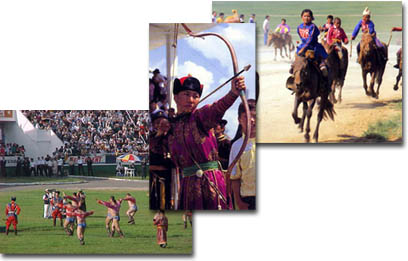
HISTORY OF NAADAM
The origins of the Naadam Festival go long way back into times primordial when horse was domesticated and first hunters learned how to ride them. Though the historical evidence is not available, the festival roots can be traced in the culture to such Central Asian nomadic tribes as Huns, Scyphians and Turks.
As early as 3,000 year B.C. the holiday become a regular national event when all the nomad tribes would come together to show the best of their physical strength, riding and shooting skills, qualities vital for the survival of nomad herders and hunters.
This tradition of annual festival survived throughout the centuries of turbulent history of Central Asian nomads.
After 1921, the Naadam Festival became an official celebration of the National Revolution's victory. On June 11 the revolutionaries mounted a successful attack on Urgoo, the capital city, and expelled Chinese military garrison.
Nowadays, it is simply the Naadam Festival.
The festival begins with a ceremonious ride by medieval warriors bearing the Nine Banners of Chinggis Khaan. It has replaced the seven decades long tradition of military parades and demonstrations praising the Communist party.
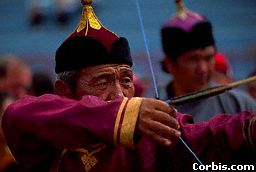
ARCHERY SHOOTING
Mongols are almost born with the archery skills, an integral part of nomads lifestyle. From the very childhood such qualities as perfect eyesight, measurement, patience and strength are nourished to develop a good archer.
Mongolian bows are very tight ones, so that it requires a pure strength to stretch it out.
As a rule, several teams of archers compete. Each team of 5-7 archers should hit 33 leather cylinders from a distance of 75 meters. The team, beating out first all cylinders qualifies for the next round with the number of targets sharply reduced. The last round involves only three cylinders.
During the tournament, judges stand in two sides next to the target. Each time, an archer prepares for a shot, they would start slowly the so called Uukhai song. As soon as the arrow hits the target, the song's melody changes and an experienced archer immediately learns about how many cylinders were hit.
This song is very old one. Until recently the shooting range was three times as long or about 200 meters. Therefore it was easier to convey information through a song rather than dispatching a messenger to inform about the result.
Traditionally, women did not practice archery, but in the last two decades they made a steady progress. On the picture - four times winner of the Naadam Archery Tournament Ch. Munkh Tsetseg. She received her first title while she was a young girl in 1982 and now her title is Unparalleled One.
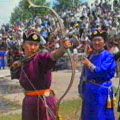 |  |
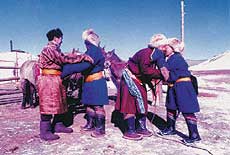
TSAGAAN SAR, THE LUNAR NEW YEAR
By T.Enkhbold
According to Mongolian lunar calendar, the year 2000 is a year of an Iron Dragon.
Tsagaan Sar or White Month is one of Mongolia's two major and long-awaited holidays, the other being Naadam in July. For Mongols, Tsagaan Sar is not only an ancient holiday marking the end of winter and the beginning of a new year's cycle, but is also a time for unification and reinforcing social bonds.
Preparations for the festive start well ahead of time. Several families usually gather in the eldest man's gher (round, felt covered traditional dwelling), where the holiday will take place.
Since the holiday means all relatives, neighbors, friends and guests will be treated to a lavish meal, women make more than a thousand buuz and dumplings. Ready dumplings are lined on wooden plates and put outside. The next day, the frozen buuz are ready to be steamed. Families all across the country stock-up on food, diary products, mild milk vodka and other specialties for the occasion.
Bituun - last dinner of the outgoing year. bituun, meaning "to close down", takes place on the last day of the lunar month. Beforehand, all the business of the past year must be wrapped up; debts paid and good relationships restored.
"Our family began preparations almost one month ago," says D. Batdelger, a herder in Binder soum of Khentii province. "First of all, I repaired and cleaned out all the sheds, including the shelter for the cattle. And I've made a trip to town for New Year gifts and food supplies... Both my wife and I have had our hands full."
The hostess of the gher, Odiima, is bustling around the stove, cooking the New Year dinner.
"One is supposed to see in the New Year wearing all new clothes," she says. "So, this year I made new dels (national dress) for my husband, children, grandchildren, and myself.
"My daughter and I have made plenty of buuz and banshi (steamed meat dumplings and lamb patties) for the holiday as well as baking boov (biscuits). And yesterday, of course, we did a thorough cleaning so that on Tsagaan Sar there would not be a speck of dust in our gher."
The bituun evening is mainly celebrated in close family. In the evening, when all the family members gather, the women start to set the table. All guests straighten their clothes, put on their caps and take a seat around the table, according to their age and family hierarchy.
Date of Tsagaan Sar celebration
Lunar New Year, as in many Asian countries, calculated on a lunar calendar sometime between the end of January and start of March. But it often falls on the first new moon in February. Marks the start of the 'white' month; the name could originate from the white winter or milk dishes. But, by and large, Mongolians associate the color white with happiness and health.
And then bituun begins - the last dinner of the outgoing year. That evening, one must try all the dishes: boiled meat, a variety of milk products, meat dumplings and dessert... That means a long dinner late into the night. Usually airag (a mild beverage made of fermented mare's milk, often called "white beer"), mild vodka and tea with milk are served with the dinner.
Tradition states that before starting the meal, the host parts with the old year in a symbolic ceremony. Having placed a leg of lamb on his plate, he slices it and gives everyone a piece. Then he breaks the bone and draws out the marrow, thus symbolizing the opening of the New Year.
Dinner is lively: adults tell funny tales, sing and play with the children. Everyone has to feel cheerful and full of food, so that the family will also feel content in the next year. Even dogs are given extra bones to fill them up. 
HORSE RACING
Probably no people have more intimate understanding of, and pride in, their horses than Mongolians, who greatly depend on them for sustenance and transport.
There are normally six categories of horse racing, depending on the age of the horses: for example, a two-year-old horse, called a shudlen, will race for 15km, and six- and seven-year-old azrag and ikh nas horses go for up to 30km. There are no tracks or courses; it is just open countryside. The horses in each category are taken from the starting line to some designated landmark a suitable distance away, and then race back. Jockeys boys and girls aged between 5 and 13 years old prepare for months for special races, particularly at Naadam, and horses are fed a special diet for weeks beforehand.
Before a race, the audience, all decked out in traditional finery, often sings traditional songs. The young riders sing a traditional anthem called a gingo before the race, and scream Goog at the horses during the race.
The winner is declared tummy ekh, or leader of ten thousand. The five winning horses are admired and talked about in reverence by the crowd, and traditional poems are read out extolling the virtues of riders and trainers. The five winning riders must drink some special airag, which is then often sprinkled on the riders heads and on the horses backsides. During Naadam, a song is also sung to the two-year-old horse which comes last.
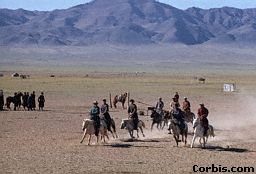
NAADAM FESTIVAL or THREE MANLY GAMES
Naadam (naa-dm) that is how Mongols call one of two largest national holidays. The name of the festival means competition, sports.
Indeed, it is a true test of manhood in such traditional games as horse racing, archery and wrestling. The wrestling enjoys special popularity comparable to that of baseball in the United States or sumo wrestling in Japan.
The festival usually takes place in mid-summer, during a brief period between spring and autumn seasonal jobs.
|
|  |
 |
 |
 |
 |

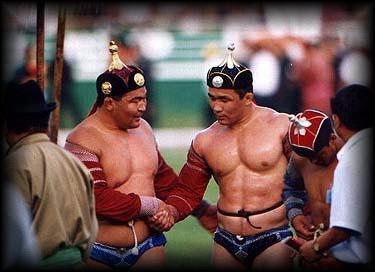
WRESTLING
The wrestling tournament is the focal point of the festival. Altogether 1024 wrestlers step out onto the arena at the start of the wrestling tournament. Wrestlers slowly come up waving their hands imitating the flight of a mythical Phoenix bird.
Wrestlers then divide into two groups on two sides of the arena. One by one, secoundants sing a long praise for the wrestler's qualities, the rank and past victories. Then they call out the name of the wrestler contender.
Once wrestlers know who will face whom, after a signal they converge in a fierce battle. After half an hour the weakest ones are knocked out and the winners of the first round emerge, proudly waving their hands imitating an eagle's flight.
Winners then they again split into two groups and start to call out their next contenders.
The tournament lasts for two days and after eight matches only the strongest ones remain to wrestle for the title of a Titan, the highest rank.
The rules of wrestling are rather simple-- anybody who touches the ground first is defeated. The rules also are demanding ones as neither wrestlers' weight nor height is accounted for. 
The match time is not limited either and sometimes wrestlers become stalled like a pair of bulls, waiting for one another to make a fatal mistake. Only the angry shouts by funs may force them to try their last and favorite trick. Therefore, such qualities as ability to withstand on feet, masterful command of every possible reception, dodges are vital for winning.
Each Mongolian wrestler has a title of his own: Lion, Elephant, Falcon, - a sophisticated hierarchy of ranks bestowed depending on the wrestler's past performance. Such definitions as Steady, Mighty and Strong are usually added to wrestler rank, to reflect their specific wrestling style or quality. The champion of the tournament is awarded the title of The Titan.
B. Bat Erdene, winner of the Naadam Festival wrestling for 11 times. For this achievement he was awarded such praises as Glorious and Unbeatable Titan. On the international level he is more known as the silver medal winner in judo and bronze medal from Asian Sumo Wrestling. He is now 36-year-old, married and has two children.
 |
 |
|
|